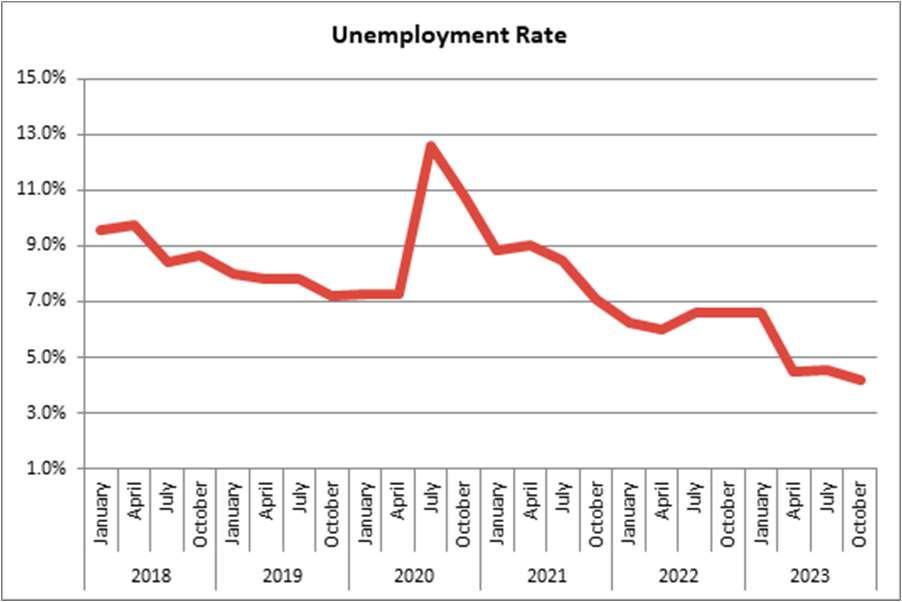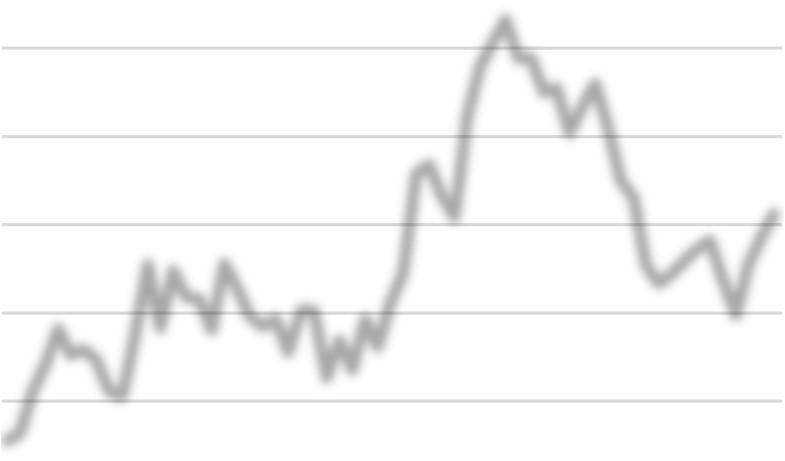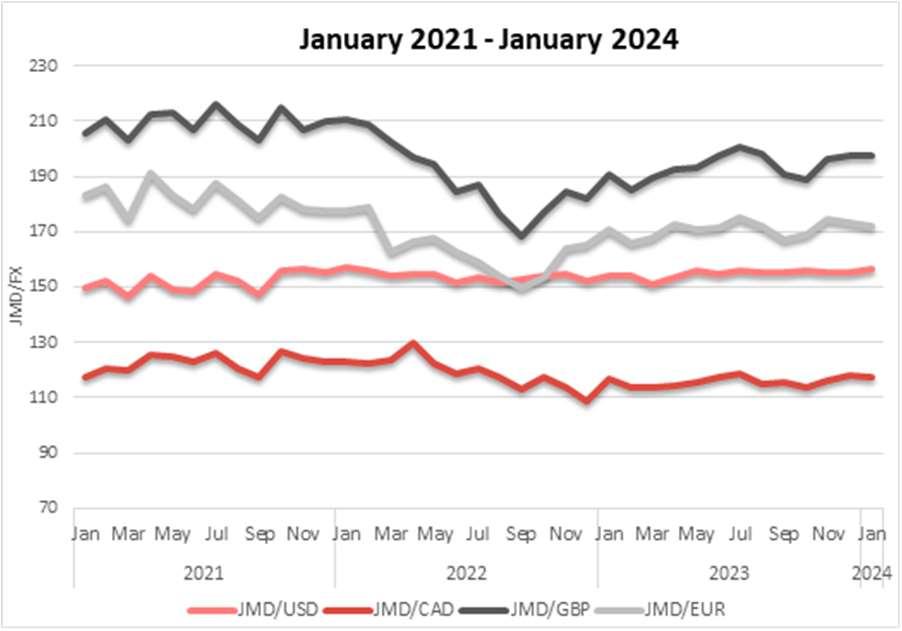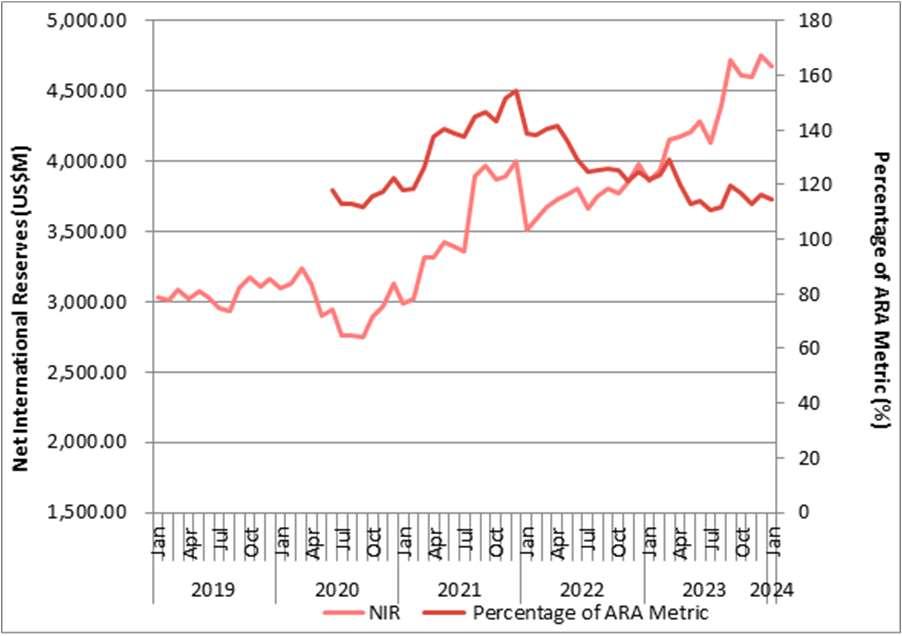


Economic Bulletin

















In October 2023, an additional 50,400 individuals were employed when compared to October 2021, the last corresponding period whereasurveywas done,leadingto a 241-basis point (bps) reduction in the unemploymentrate,whichcameinat4.20%. This is the lowest unemployment has ever beeninthecountry.Notably,therewasarise in employment particularly among males in thecategoriesof'Serviceworkersandshop’ and‘Marketsaleworkers’alongwith'Skilled agriculturalandfishery.Intermsofindustry, the most significant surge in employment occurred in the 'Real Estate and Other Business Services' and 'Construction' sectors.

The point-to-point inflation rate for January 2024gained39basispointsabovetheBank ofJamaica’s(BOJ)4%-6%inflationtargetto endat7.39%.Theprimarydriversofthis12month increase were the surges in the divisions of 'Food and Non-Alcoholic Beverages,' which saw an 8.90% increase, Transport 9.50% and ‘Housing, Water, Electricity, Gas and Other Fuels’ by 4.60%. Main risks to inflation continue to be the increase in taxi fares as well as wage increases in the private sector due to job markettightening.


Withtheinflationratenowtrendingabovethe policy rate, the BOJ Monetary Policy Committee (MPC) meeting which occurred on February 20 upheld the rate at 7.00%. However,thepossibilityforfutureratehikes has increased as the bank expressed concerns as inflation has trended above its upperlimitforthepastthreemonths.Inflation isexpectedtoremainabovetargetduringQ1 2024.Maindownsideriskstothepolicyrate increasing are the wage increases in the privatesectoraswellassupplychainissues in the Panama Canal and geopolitical tensionsintheRedSea.
At the end of January 2024, the Jamaican dollar depreciated by 0.93% month-overmonth to the US dollar, with the weighted average selling rate (WASR) moving from $154.95 at the end of December to close January at $156.41. During the month, the central bank intervened in open market operations via the Bank of Jamaica (BOJ) Foreign Exchange Intervention Tool (BFXITT)flash saleoperations on four trading days,January15,16,25and26,injectinga totalofUS$100millionintothemarket.Sofar this month, the BOJ has intervened in the marketontwotradingdays,February6and 7,injectingatotalofUS$50million.TheBOJ isexpectedtomaintainitsinfluenceoverthe foreignexchangeratemarket,asitsreserves continuetogrowstrongly.


Thestockofnetinternationalreserves(NIR) asatend-January2024wasUS$4.68billion, reflecting a decrease of US$79.15 million from the end of December. The decline in NIR was primarily due to foreign assets, which decreased by US$80.12 million, mainly due to a US$82.48 million decrease incurrencyanddeposits.Meanwhile,foreign liabilitiesdecreasedbyUS$0.97million,with liabilities to theInternational Monetary Fund (IMF) accounting for 100% of total foreign liabilities,ofUS$109.43million.
United States
Indicator Dec 2023 Jan 2024
In January, the ISM Manufacturing PMI increased to 49.10%, showing a 2percentage point risefrom December 2023, but signifying the Manufacturing sector's 15th consecutive month of contraction. Conversely, the Services sector expanded forthe13thstraightmonth,withtheServices PMI reaching 53.40%, up by 2.90 percentagepointsfromDecember.Despitea 1 percentagepoint decrease in the Hospital PMI to 61.50% in December 2023, counter developmentsinmanufacturingandservices sectors resulted in a stable unemployment rate of 3.70% in January, a slight increase fromthepreviousyear's3.40%.
Jobgrowthinhealthcare,businessservices, and social assistance supported consumer spending.Althoughthelabormarketcooled, consumer spending's inflationary impact kept the inflation rate at 3.70% in January. Existing home sales dropped 1.00% in December2023to3.78million,witha6.20% year-over-year decrease. The recent surge inhomeprices,drivenbyinflationandrising mortgage rates, is expected to cool down duetoitsunsustainablenature.
The US economyremains resilient, withQ4 2023 GDP growth at 3.30%, surpassing expectations. A "soft landing" possibility is increasing. Despite US inflation exceeding theFED’s2.00%target,expectationsarefor a gradual decline in 2024. This anticipated trendmayleadtotheFedreducingthepolicy rate, fosteringmoreeconomicgrowth and a reboundinfinancialmarkets.

Indicator
Source: National Bureau of Statistics of China
ForthemonthofJanuary2024,theyear-onyear national Consumer Price Index (CPI) experienced a decrease compared to the previousyear.Thiswasprimarilyduetothe decrease in the cost of food items, which recorded a 5.9% decline and consumer goodswhichdecreasedby1.7%.Thecostof non-food items, however, experienced a 0.4% increase, similar to services which recordedanincreaseof0.5%.
China's manufacturing industry though previously on a downward trend, experienced a slight increase in its Purchasing Manager Index (PMI) relativeto December, indicating a rebound in the climate level of the manufacturing industry. Overall, for 2023 China’s economy showcasedanincreaseof5.2%intheirGDP overthepreviousyearatconstantprices.
Source: Eurostat; the Statistical office of the EU
In December 2023, EU overall inflation showcasedachangeintrajectory,recording itsfirstincreasesinceOctober2022.Despite this, the unemployment rate continues to maintainthehistoricallylowraterecordedin May 2023. The EU’s economic sentiment alsocontinuedanupwardtrajectory,though remaining significantly below its prepandemic levels. The improvement of the ESI continues to be driven by higher confidence among consumers and managers in retail trade, services and construction, while confidence in industry remainsbroadlyunchanged.
Retail trade, industrial production and production in services experienced a slight decline for the month of November, though remaining above pre-pandemic levels. This decline has contributed to the flat trend in GDP growth experienced over the last four quartersof2023.
Trinidad
Source: Central Bank of Trinidad & Tobago
Asmacroeconomicconditionscontinuetobe favorable, showcasing a downward trend in inflation and sustained credit growth in the private sector, the Central Bank of Trinidad

and Tobago has maintained the monetary policy rates at 3.50% for December and beyond,into2024.
The IMF sustains the growth outlook for Trinidad and Tobago at 2.50% in 2023 and 2.20% for 2024. With inflation easing faster than anticipated and prospects for a ‘soft landing’ gaining momentum across several advancedandemergingmarketeconomies, internationalmacroeconomicconditions appear relatively less constrained towards theendof2023. Thisscenariopresentsthe potential opportunity for an elevation in the projectedgrowthoutlook.
Dominican Republic
Indicator Dec 2023 Jan 2024
4.7% N/A
Source: Central Bank of the Dominican Republic
For the month of January 2024, the Central Bank of the Dominican Republic (BCRD) further maintained its monetary policy rate (MPR)at7.00%annually.
Comparedtothepriormonth,theDominican Republic experienced an increase in the inflation rate. Notwithstanding, the rate is forecasted to remain primarily within the target range of 4.0% ± 1.0% during 2024.
Additionally, an expansion of the monthly indicatorofeconomicactivity(IMAE)of4.7% year-on-year in the month of December, contributedtoagrowthof2.4%.
It is expected that monetary stimulus and greater public investment will continue to contribute to boosting economic activity towards its potential growth of 5% during 2024, which would be one of the highest expansions in the region during this year. Overall,theDominicaneconomyisinagood position to continue facing the challenging panorama, considering the strength of its macroeconomic fundamentals and the resilienceoftheproductivesectors.
Mexico
Indicator Dec 2023 Jan 2024
Headline
Source: Banco de Mexico, Bloomberg
TheMexicaneconomyisexpectedtoexhibit robust growth in 2024. The expansion of economic activity will be driven mainly by domestic spending, supported by the expectation that both consumption and investment will continue to expand, along with the expansionary fiscal stance announced for the year. The central bank, Banco de Mexico, estimates that the economy willgrowbetween 2.3%and3.7% in 2024, with the bank projecting a strengthening of economic activity for the firsthalfoftheyear,andthereforecontinues

to maintain its monetary policy rate at 11.25%.Regardinginflation,itisexpectedto continue its disinflationary trend throughout 2024, with a projected convergence to the 3%targetbythesecondquarterof2025."
Colombia
Indicator Dec 2023 Jan 2024
Source: Banco de la República Colombia
The Central Bank of Colombia reduced the monetary policy rate by 25 basis points, effective January 2024. This decision was influencedbythedecreasingtrendofannual inflation, improved external conditions, and thestrengtheningoftheColombianeconomy due to a reduction in external imbalances. Annual inflation has decreased forthetenth consecutivemonth,attributedtoasignificant decline of 5% in core inflation rates. However, a prolonged economic slowdown persists, with significant investment contractions in housing, machinery, equipment,andcivilworks.Notwithstanding, the growth forecast for 2023 remained at 1.0%,withaprojected0.8%growthfor2024.
Concerns about the severe drought caused bytheElNiñophenomenonanditspotential impactonachievingthe3.0%inflationtarget continuein2024.Additionally,theeconomic impacts of the recent minimum wage increasewarrantclosemonitoring.
Peru
Indicator Dec 2023 Jan 2024
Source: Central Reserve Bank of Peru
The Central Reserve Bank of Peru (BCRP) has maintained the trend of reducing the monetarypolicyrateeffectiveJanuary2024 with a base point reduction of 25-basispoints. This decision was influenced by the continual decline in both headline and core inflationratesCoreinflationhassignificantly decreased, now falling below the target of 3.0%. While, headline inflation, remains slightly above target, it is expected to align withthetargetintheupcomingmonths.
Regardingeconomicactivity,theleadingand expectations indicators in December, although showing moderate improvement, still predominantly signal pessimism. The economyfaceschallengesduetopersistent shocks from social conflicts in 2023, the ongoing drought linked to the El Niño phenomenon, and global uncertainties, including international conflicts and deceleratinggrowthinChina.
Indicator Dec 2023 Jan 2024
CPI (annual) 3.9% N/A
(monthly) -0.5% 0.7%
8.25% 7.25%
Source: Banco Central de Chile
The Central Bank of Chile has continued to reduceitsmonetarypolicy rate, effectuating a significant cut of 100 basis points. This

strategicdecisionaimstobolstertheongoing decline in inflation, as evidenced by the annual Consumer Price Index (CPI). It is anticipated that inflation will align with the bank's target range of 3.0% by the second half of 2024. Simultaneously, the monetary policy rate is expected to stabilize at its neutral level during the same timeframe. Despite these monetary policy adjustments, the sentiment among households and businesses remains predominantly pessimistic.
Jamaica has recorded a landmark achievementasofOctober2023,registering its lowest unemployment rate in history at 4.2%.Thisratedemonstrateslabourmarket efficiency, aligning with that of the United Kingdom’s figures, surpassing Canada’s of 5.8% and marginally exceeding the United States’unemploymentrateof3.7%.Despite the expansion of the labour force, and the maintenance of moderate price stability, alongside sustained growth, of the local economy, this unemployment rate is forecasted to remain relatively low in the shorttomediumterm.Whilethisisbeneficial for Jamaica's economy, amidst this historic achievement, businesses in Jamaica continuetoexperiencealaborshortageand callfortheimportationofskilledlabor.
In2022,theHEARTTrustNTAconducteda Skills Gap Analysis to assess the areas of labour shortage in Jamaica. The results identified approximately 133 skill gaps
existing across the nine internationally competitive sectors of agriculture, mining and quarrying, the creative industries, manufacturing,construction,tourism,sports, information and communication technology (ICT) and the services sector. Since 2022 this gap has further worsened, posing a significantchallengetothesustainedgrowth anddevelopmentofJamaica'seconomy.
Amidst Jamaica’s low unemployment rate, there is an ongoing labour shortage that raises critical questions about the dynamics of Jamaica's workforce. Despite the availability of jobs, businesses struggle to find qualified individuals to fill crucial roles, hinderingproductivity.Whiletherehasbeen a push to modernize curricula and incorporatetechnicalandvocationaltraining, progress has been slow, leaving many graduates ill-prepared for the demands of today's job market. Additionally, the rapid pace of technological advancement necessitates continuous upskilling and reskilling, further widening the gap between availabletalentandindustryneeds.
In response to this phenomenon, a publicprivate sector multi-faceted approach is needed. This approach should involve investing in education and training to align traininginitiativeswithindustryneedsforthe longterm,whilealsoincorporatingmeasures to address the skills gaps in the short to medium term.,. Initiatives should encourage innovationandentrepreneurship,embracing technologicaladvancements,andfacilitating ease of labour importation. By adopting a comprehensive approach, Jamaica can unlock the full economic benefits of its low unemployment rate and create a more prosperousfutureforallitscitizens.

Sources: Statistical Institute of Jamaica (STATIN),BankofJamaica(BOJ),Planning Institute of Jamaica (PIOJ), Bloomberg, International Monetary Fund (IMF), Observer, Gleaner, US Bureau of Labour Statistics, US Census Bureau, Institute for SupplyManagement,NationalAssociationof Realtors,CentralBankofBarbados,National Bureau of Statistics of China, Central Bank of the Dominican Republic (BCRD), Banco deMexico,BancodelaRepúblicaColombia, Central Reserve Bank of Peru, Banco CentraldeChile,Eurostat





* Projections are taken from Bloomberg survey of economists as of February 20, 2023.
